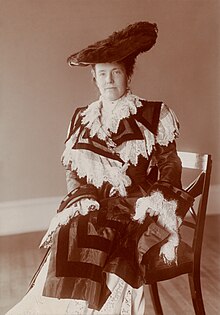
Back إديث روزفلت Arabic اديث روزفلت ARZ Edith Kermit Carow Roosevelt AST Edit Ruzvelt Azerbaijani ایدیت روزولت AZB Эдзіт Рузвельт Byelorussian Едит Рузвелт Bulgarian Edith Kermit Carow Roosevelt Catalan Edith Rooseveltová Czech Edith Roosevelt German
Edith Roosevelt | |
|---|---|
 Portrait, c. 1903 | |
| First Lady of the United States | |
| In role September 14, 1901 – March 4, 1909 | |
| President | Theodore Roosevelt |
| Preceded by | Ida Saxton McKinley |
| Succeeded by | Helen Herron Taft |
| Second Lady of the United States | |
| In role March 4, 1901 – September 14, 1901 | |
| Vice President | Theodore Roosevelt |
| Preceded by | Jennie Tuttle Hobart |
| Succeeded by | Cornelia Cole Fairbanks |
| First Lady of New York | |
| In role January 1, 1899 – December 31, 1900 | |
| Governor | Theodore Roosevelt |
| Preceded by | Lois Black |
| Succeeded by | Linda Odell |
| Personal details | |
| Born | Edith Kermit Carow August 6, 1861 Norwich, Connecticut, U.S. |
| Died | September 30, 1948 (aged 87) Oyster Bay, New York, U.S. |
| Resting place | Youngs Memorial Cemetery |
| Spouse | |
| Children | |
| Parent |
|
| Signature | |
Edith Kermit Roosevelt (née Carow; August 6, 1861 – September 30, 1948) was the second wife of President Theodore Roosevelt and the first lady of the United States from 1901 to 1909. She was previously the second lady of the United States in 1901 and the first lady of New York from 1899 to 1900.
Growing up alongside the Roosevelt family, Edith Carow began a romance with Theodore Roosevelt as a teenager and became a New York socialite. After a falling out in young adulthood, they split up and did not rekindle their friendship until after Theodore was engaged to Alice Hathaway Lee. Edith and Theodore were engaged shortly after Alice's death, and Edith took in Theodore's daughter, also named Alice, as a stepdaughter. They moved into their new home, Sagamore Hill, and she had five children with Theodore. They stayed in Washington, D.C. while Theodore was on the Civil Service Commission, where Edith established a social network of prominent figures, including Henry Adams. The Roosevelts moved back and forth between New York and Washington as Theodore's political career progressed, and she became a public figure as Theodore's wife as he became a war hero in the Spanish–American War and got elected governor of New York. She became second lady of the United States when Theodore was elected Vice President of the United States, and she became first lady shortly after when President William McKinley was assassinated, propelling Theodore to the presidency.
The exact nature of Edith's influence over Theodore's presidency is unknown, but they frequently spoke about politics and he often took her advice. She kept her husband informed of news stories that she deemed important, and she worked as an intermediary to get information for him. Edith resented the press, and she used her influence to control press coverage. To prevent intrusion on their personal lives, she had photographs produced of the family and gave them to the press. She also controlled Washington social life, organizing weekly meetings of the cabinet members' wives, from which she became the gatekeeper of who could attend formal events. Edith made charitable donations throughout her tenure as first lady, and she featured various musical artists at the White House to promote their work. She disapproved of Theodore's chosen successor, William Howard Taft, and had an animosity toward his wife Helen Herron Taft. Edith's most enduring legacies are her oversight of the 1902 White House renovations and her hiring the first social secretary for a first lady, Belle Hagner.
Edith took up travel in the years after leaving the White House, touring Europe and Latin America for the first of many times. She was severely injured after being thrown off of her horse in 1911, permanently losing her sense of smell. Though she disliked Taft and Woodrow Wilson, Edith discouraged Theodore from his campaign against them in the 1912 presidential election, which he lost. Her health declined in the 1910s, and she was devastated by the losses of her son Quentin in 1918 and then her husband in 1919. She remained politically active, supporting Warren G. Harding in 1920 and Herbert Hoover in 1932—the latter being an effort to distance herself from Hoover's opponent, Theodore's distant cousin Franklin D. Roosevelt. Edith took an interest in her ancestry in 1920s, writing a book on her ancestors and purchasing her ancestral home in Brooklyn, Connecticut. She lost two more of her sons in the 1940s, and was bedridden for the last year of her life. Edith died on September 30, 1948. Historians have consistently ranked her in the upper half of first ladies in periodic polling by the Siena College Research Institute.
© MMXXIII Rich X Search. We shall prevail. All rights reserved. Rich X Search